DMM Aneng H01
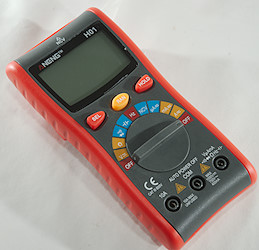
This is a fairly cheap Aneng multimeter, but is has most of the common ranges.
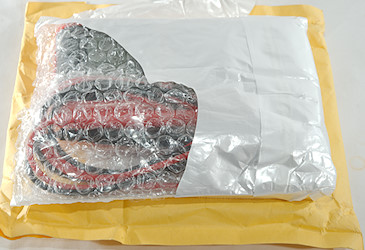
I got the meter without a box
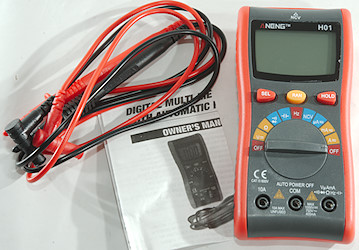
It included the meter, probes and a instruction sheet that do not match the meter.



Probes are not branded and are specified for CAT III, this cannot be true with that much tip exposed.
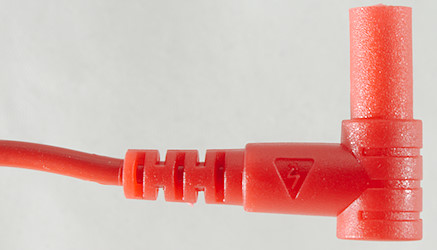
The plug is fully shrouded but very short with 13.7mm shroud.
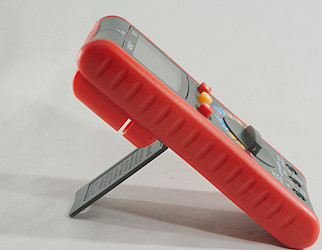
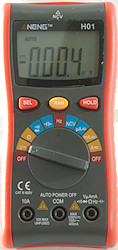
Pressing on the meter the rotary switch can be turned when the meter is on its tilt stand.

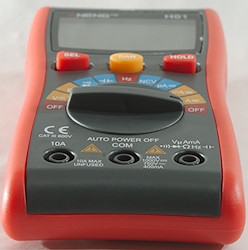
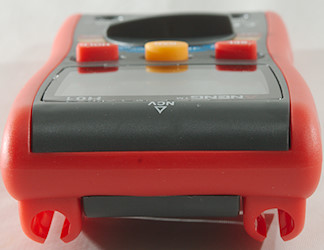
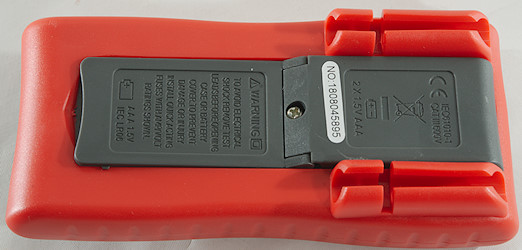
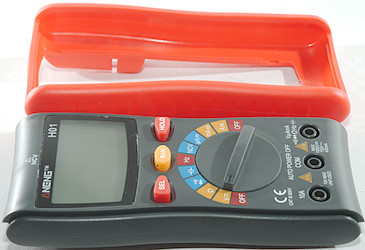


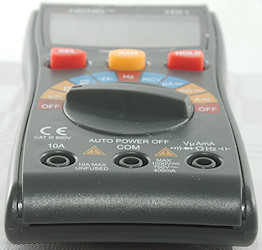
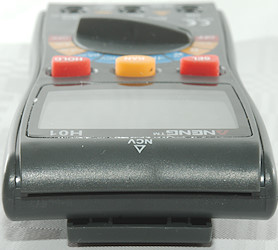

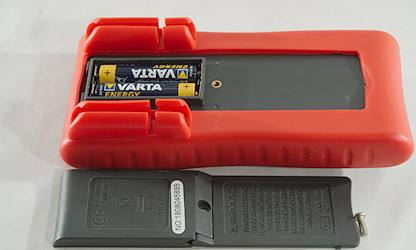
Display
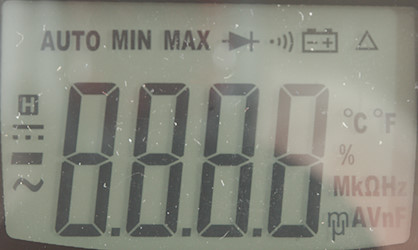
The above picture shows all the segments on the display, a few of them are not used.
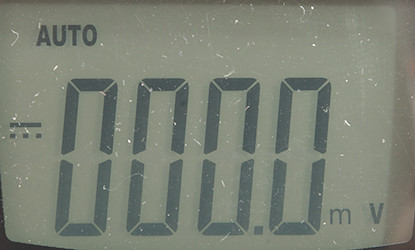
Usually the meter shows the selected range and the value.
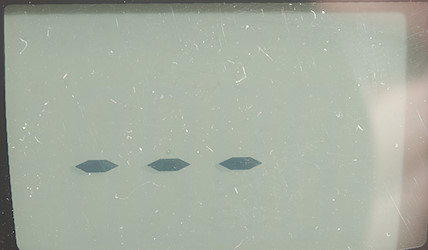
The Non contact voltage detector is the usual bars.
Functions
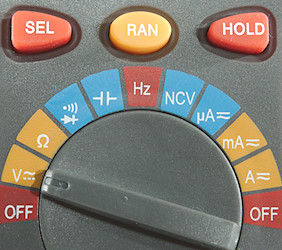
Buttons:
-
SEL (red): Select AC/DC in voltage and current and changes between diode/continuity.
-
RAN (yellow): Switch to manual range and select range, hold down to activate automatic ranging again.
-
Hold (red): Freezes the current displayed value.
Rotary switch:
-
Off: Meter is turned off.
-
V: Voltage DC and AC, use SEL to switch. The VDC range has a mV range
-
 : Resistance
: Resistance -
 : Diode and continuity
: Diode and continuity -
 : Capacitance
: Capacitance -
Hz: Frequency.
-
NCV: Non contact voltage detection.
-
uA: The uA range.
-
mA: The mA range.
-
A: The A range.
-
Off: Meter is turned off.
The color scheme around the rotary switch looks like it was added for design, not to help with identifying similar ranges and the yellow button also affect a blue range (uA).
Input
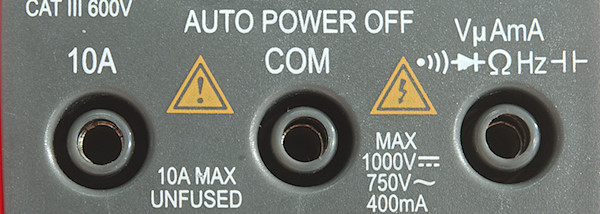
-
A: High current, maximum current is 10A
-
CON: The common terminal for all ranges.
-
xxx: All other ranges.
Measurements
-
Volt and frequency
-
At 0.1Vrms logical frequency input (Hz) range is from 0.8Hz to 3MHz
-
At 1Vrms logical frequency input (Hz) range is from 0.5Hz to 30MHz
-
Logical frequency input (Hz) requires a zero crossing.
-
1 VAC is 5% down at 2.4kHz (RMS will not work at the frequency).
-
There is audible alarm above 600V
-
Input impedance is 10-11Mohm on mVDC/mVAC/DC/AC
-
Frequency input has high input impedance up to about 2V then drops to about 1-3kOhm
-
Rated overload protection on V ranges is 600VDC/AC
-
-
Current
-
Overload protection in uA and mA is a SMD fuse rated for 0.25A according to the circuit board text.
-
There is no overload protection in ampere, the range is unfused.
-
There is audible alarm on the 10A range when at 10A or above.
-
The mA fuse cannot handle the full 0.4A for long, because it is only 0.25A
-
-
Ohm, continuity, diode and capacitance
-
Ohm needs about 2.8s to measure 100ohm
-
Ohm is 1.0V open and 0.35mA shorted
-
Continuity is fast (20ms).
-
Continuity beeps when resistance is below 50ohm
-
Continuity is 2.1V open and 0.34mA shorted
-
Diode range uses 2.3V, max. display is 2.000V at 0.14mA, max. current is 1.2mA shorted
-
10uF takes about 2.2 seconds to measure.
-
Rated overload protection on ohm ranges is 250 VDC or VAC
-
-
Miscellaneous
-
Meter in off has down to 1kOhm input impedance, i.e. a PTC
-
Current consumption of meter is 1.0mA-1.8mA, VDC has the highest current drain.
-
Meter works down to 2.2V, where it may turn off or reset, battery symbol show at 2.3V.
-
The meter reading is stable until the meter turns off.
-
The meter usual shows correct in first display update, but may delay that update a second.
-
Viewing angle is good, except from the top.
-
Display updates around 3 times/sec
-
Will automatic turn power off in about 16 minutes
-
Standard probes cannot be pushed fully down.
-
Weight is 170g with batteries and sleeve.
-
Size is 146 x 72 x 33mm.
-
-
Probes
-
Probe resistance about 110mOhm for one.
-
Probe wire 84cm long.
-

A look at the capacitance measurement waveform when measuring 1uF

Frequency input resistance, the impedance is a bit above 1Mohm up to around 2V where it drops to 2kOhm
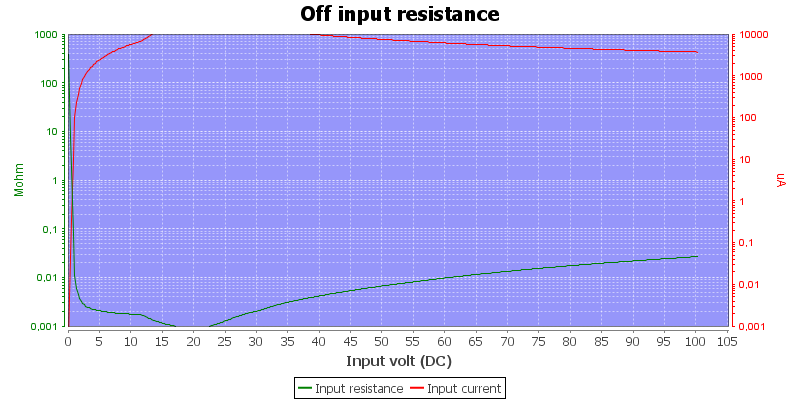
The input resistance in off is rather low.

Meter is true-rms
Large DC values will block for AC readings.
The supplied manual do not match the meter, i.e. the tolerance specifications and overload ratings are probably wrong.
The mA fuse is only 0.25A
Tear down
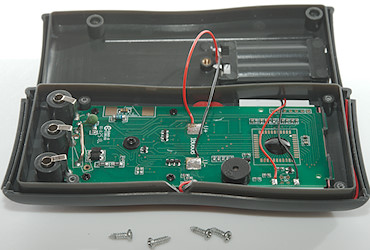
I had to remove four screws to open the meter.
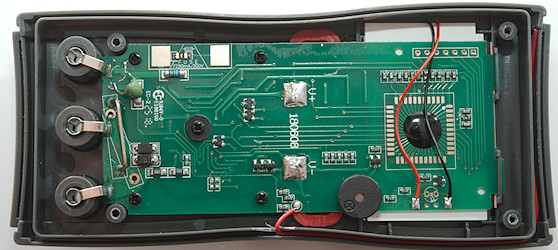
The NCV antenna is a wire going into a cut slit in the enclosure and the wire is damaged from that.
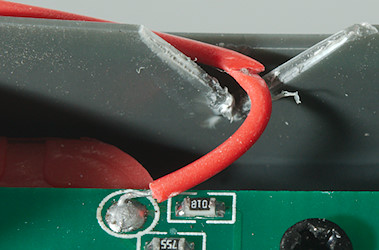
A closeup of the NCV antenna.
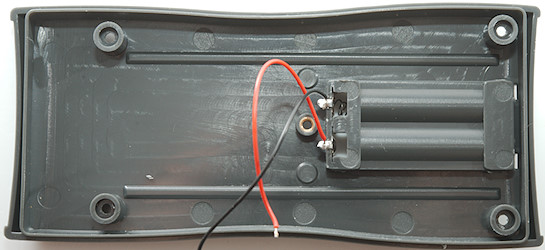
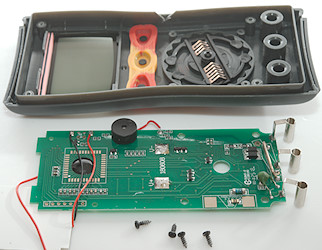
Four more screws and I could remove the circuit board.
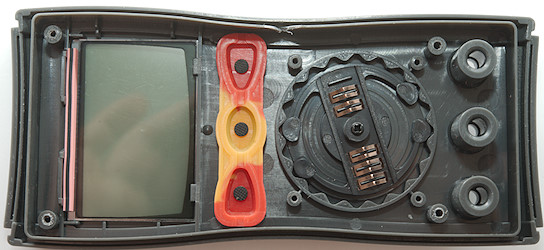
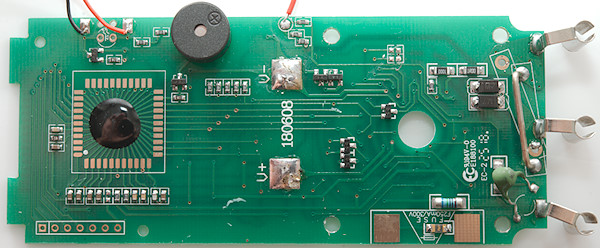
The 10A current shunt is a but thin, but works fine. The uA (1000: 100ohm) and mA (1R00: 1ohm) resistors next to it together with the protection diodes (2xM7), a fast check shows they will drain about 15uA at 0.4V at about 25°C, this is the 4000uA range (this is 0.4% error and tolerances says 1%).
The voltage input has the usual resistor (10Mohm) next to the fuse. For ohm/diode/continuity/capacity the PTC and a transistor pair (Marked Y1) protected the current output, the input uses a 1Mohm resistor (Under the PTC) directly connected to the chip. In Hz the PTC and same transistor pair is used.
This meter do not have the classical set of resistor (1k-10k-100k-1M) for the ranges, maybe they are inside the chip.
A little test: 4000uA current, display shows 4015uA, hit the diodes with a heat gun at 100°C for a short time, display shows 3900uA.

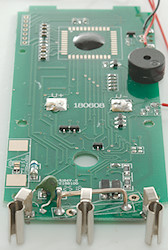
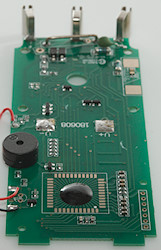

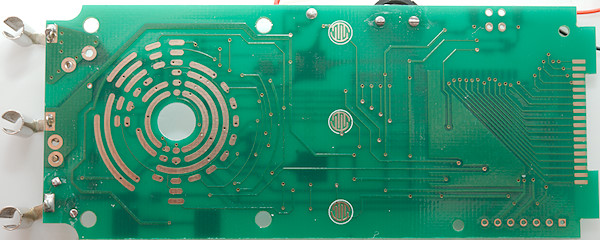



Conclusion
The CAT rating is not correct, unfused cannot be CAT rated.
The meter is very cost optimized with nearly everything in a single chip, but I do not like that the meter uses a SMD fuse on mA and it may easily blow if using the full mA range. The partly cut through NCV antenna is also bad.
The meter has a good selection of ranges, but there are a couple of omissions and not that many functions
Notes
How do I review a DMM
More DMM reviews